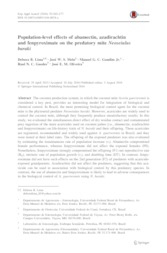Population-level effects of abamectin, azadirachtin and fenpyroximate on the predatory mite Neoseiulus barak.
Population-level effects of abamectin, azadirachtin and fenpyroximate on the predatory mite Neoseiulus barak.
Author(s): LIMA, D. B.; MELO, J. W. S.; GONDIM JÚNIOR, M. G. C.; GUEDES, R. N. C.; OLIVEIRA, J. E. de M.
Summary: The coconut production system, in which the coconut mite Aceria guerreronis is considered a key pest, provides an interesting model for integration of biological and chemical control. In Brazil, the most promising biological control agent for the coconut mite is the phytoseiid predator Neoseiulus baraki. However, acaricides are widely used to control the coconut mite, although they frequently produce unsatisfactory results. In this study, we evaluated the simultaneous direct effect of dry residue contact and contaminated prey ingestion of the main acaricides used on coconut palms (i.e., abamectin, azadirachtin and fenpyroximate) on life-history traits of N. baraki and their offspring. These acaricides are registered, recommended and widely used against A. guerreronis in Brazil, and they were tested at their label rates. The offspring of the exposed predators was also evaluated by estimating the instantaneous rate of population increase (r i ). Abamectin compromised female performance, whereas fenpyroximate did not affect the exposed females (F0). Nonetheless, fenpyroximate strongly compromised the offspring (F1) net reproductive rate (R0), intrinsic rate of population growth (r i ), and doubling time (DT). In contrast, fenpyroximate did not have such effects on the 2nd generation (F2) of predators with acaricide-exposed grandparents. Azadirachtin did not affect the predators, suggesting that this acaricide can be used in association with biological control by this predatory species. In contrast, the use of abamectin and fenpyroximate is likely to lead to adverse consequences in the biological control of A. guerreronis using N. baraki.
Publication year: 2016
Types of publication: Journal article
Unit: Embrapa Semi-arid Region
Observation
Some of Embrapa's publications are published as ePub files. To read them, use or download one of the following free software options to your computer or mobile device. Android: Google Play Books; IOS: iBooks; Windows and Linux: Calibre.
Access other publications
Access the Agricultural Research Database (BDPA) to consult Embrapa's full library collection and records.
Visit Embrapa Bookstore to purchase books and other publications sold by Embrapa.

